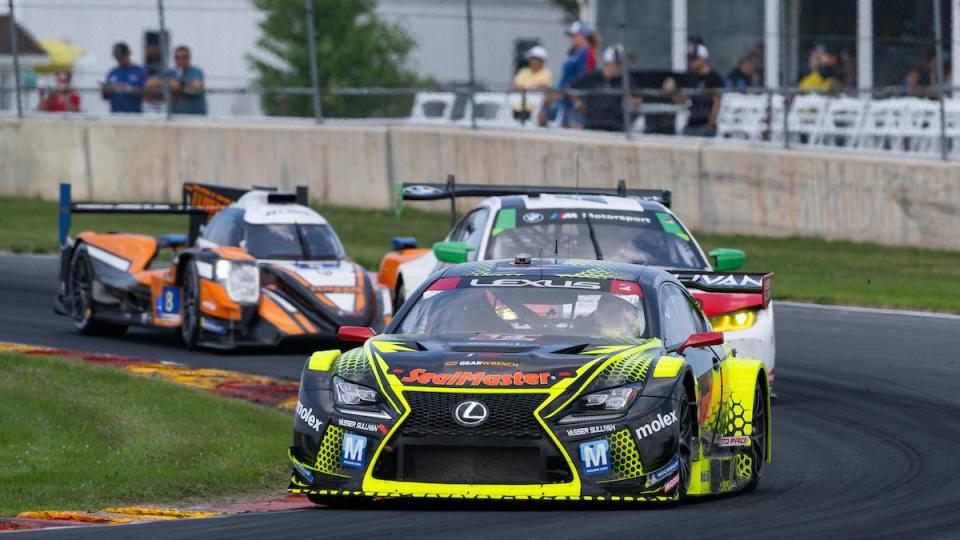For Fans' Sake, It's Time for IMSA’s GTD Pro, GTD to Become Single Pro Class

Currently, the GTD and GTD Pro classes in the IMSA WeatherTech SportsCar Championship run the same GT3 cars, and those classes are only separated by the driver ratings (GTD class allows only one driver with a pro-level rating).
A single class has the benefit of eliminating the gamesmanship involved in driver rankings.
Says IMSA president John Doonan, “It’s incumbent for us to keep what is good about it and to make it as easy to understand as possible."
Next season will be a bumper crop year for the GTD classes of IMSA’s WeatherTech Championship. The new Mustang GT3 and new Corvette Z06 GT3.R will join nine other manufacturers who race cars built to the international GT3 standard.
With so many participants and a single car specification, is it time to consider a single GTD Pro class?
As it stands, IMSA has two GT categories, one for Pro teams that allow two drivers with Gold or Platinum ratings, and the GTD class that allows only one driver with the pro-level ratings. Why not consider a future of one GT category, one championship and, above all, one winning team at each race.
This has the immediate benefit of eliminating the Abbott and Costello scenario of “Who’s on First?” that even the most astute of IMSA fans must sort through during races where the same GT3 equipment is used for two classes.
In this year’s Rolex 24 at Daytona, for example, three GTD drivers swept the top three qualifying spots for GT cars in their Mercedes AMG GT3 entries. In the race, the Aston Martin Vantage GT3 of Heart of Racing’s GTD entry led the race at the finish—while three GTD Pro drivers fought for second place and first in class. It was confusing to say the least.
A single class also has the benefit of eliminating the gamesmanship involved in driver rankings that creates a constant “competition” by drivers to retain a silver rating to make themselves more likely to be hired to fill out dance cards in what is best described as an official “semipro” class that is anything but.
The current co-leader in GTD points, Madison Snow, won his first race with his current Paul Miller Racing team in 2016 at the Virginia International Raceway, site of this weekend’s Michelin GT Challenge for the GTD classes. Seven years later, Snow is miraculously still ranked as a silver co-driver alongside the gold-rated Bryan Sellers. They have four class victories in eight starts this year.

IMSA officials are always worried about car counts. But in addition to factory-backed two-car teams from Ford and GM, there are two manufacturers that split their efforts between GTD Pro and GTD with one team—Lexus (Vasser Sullivan), and Aston Martin (Heart of Racing). It’s a way of hedging their bet and budgets when it comes to claiming at least one championship.
IMSA is committed to two GTD classes for 2024. But sanctioning body president John Doonan acknowledges that a gradual shift toward a single pro class could take place by next year’s schedule announcement. In the short term, the new GT3 cars introduced this year by Ferrari, Lamborghini and Porsche plus the new Mustang and Corvette need customers, many of whom are shy about racing against the factory teams.
“The original equipment manufacturers (OEMs) still want to have customer racing,” said Doonan. “It helps their overall business model. And a lot of them still want to have a factory team.”
Would IMSA’s already stellar GT racing be more popular if fans had only one category to follow, one winner at the end of each race and one champion? That’s how other major series operate when it comes to a single set of car rules, whether it is F1, NASCAR, IndyCar or the pro classes in the NHRA. If IMSA wants to improve its fan appeal, a single GT class makes sense for the traditional sports car endurance approach of a mix of prototypes and production-based cars.

“Even the most loyal fans of sports car endurance racing don’t always find it easy to understand,” acknowledged Doonan. “It’s incumbent for us to keep what is good about it and to make it as easy to understand as possible. The beauty of sports car endurance racing is the variety of brands and classes. At the same time, we need to do a good job or maybe a better job of keeping it simple and educating people on what it’s all about.”
The World Endurance Championship and the Automobile Club de l’Ouest officials at Le Mans seem to understand the concept of streamlining classes, having already moved to a single GTE Am class. In its first season with LMGT3 cars next year, participating teams will in effect be pro-am entries with one bronze driver required for each car.
There’s something to be said for celebrating gentlemen drivers at an event like Le Mans by putting the focus on the traditional everyman aspect of sports car racing. But it’s stretching the point when “the average Joe” is a good race car driver who also has enough wealth to help fund a team over the course of a world championship season.
IMSA has a path for those gentlemen drivers who want to be recognized for their prowess. The longstanding Bob Akin Cup was renamed the Bronze Akin Cup in 2022. The best bronze-level GT driver over the course of a season wins not only the prestigious award, but an entry at Le Mans. With a separate podium for the best bronze driver, isn’t a cup and an invitation to Le Mans—rather than a championship—enough to encourage gentlemen drivers to participate in a professional championship?
The issue of car counts is a legitimate one. But already the BMW team of Paul Miller Racing is expected to move up to GTD Pro next season. It would be a surprise if the existing Vasser Sullivan and Heart of Racing teams did not continue with two-car entries under a GTD Pro only format.
Teams want to compete for a championship as well as manufacturers. And the new Ford team and the Pratt & Miller Corvette teams will be tough to beat. But that doesn’t mean they can’t be beat by other manufacturers working closely with their teams. Last year, Porsche proved a program with factory assistance like Pfaff Motorsports could beat the well-funded efforts of Corvette and Lexus in the Pro Category.
“GTD Pro is a good opportunity for manufacturers to work closely with teams,” said Matt Campbell, who along with Mathieu Jaminet won the driver’s title with Pfaff without a full-blown factory budget.
Given the multi-class format of IMSA, where different types of cars compete in the same events, a streamlining of the GT category would fit in nicely and would not leave any class of driver on the sidelines. Most of the silver-rated drivers are legitimate golds. A way to recognize the bronze drivers is already in place.
Going forward, the universal GT3 category begs for a single professional GT championship to complement the new GTP hybrid prototypes.

 Yahoo Autos
Yahoo Autos 